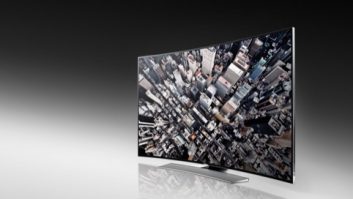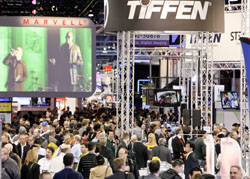
Bubbling under the surface of the Ultra HD noise at CES were autostereo technologies, with the most aggressive among those, that of Stream TV Networks.
Far from being carried on the coattails of 4K, the company boldly states that glasses-free 3D will actually drive the 4K market.
“2014 is the breakthrough year for autostereo,” said CEO Mathu Rajan at a conference session on the topic. “I’m often asked ‘when will autostereo be ready?’ We’ve spent a lot of capital and time over the last four years perfecting it and we made a conscious decision that we were not going to bring prototypes but actual products to CES. Autostereo’s time is now.” Indeed Rajan expects Stream TV “to drive the entire [autostereoscopic] category.”
Built from IP first developed, and then abandoned, by Philips and with an R&D outfit still based in Eindhoven, Stream TV operates an ‘Intel Inside’ model which sees it licence and supply the hardware, middleware and conversion technology to display makers.
It began a joint development with Hisense, the largest Chinese TV brand, 18 months ago and has an OEM partner in Pegatron, which produces 40% of Toshiba TV sets (and also counts iPad Mini and Microsoft Surface tablets as clients).
At CES, TV brands Konka, Haier, Marvel Digital and Toshiba all demonstrated Stream TV’s autostereo technology on its stand. According to Stream TV four other partners will soon be announced.
At its press conference the company said: “Now the industry is trying to push 4K TVs for viewing 2D. Beyond a certain threshold the human eye doesn’t see additional resolution at normal viewing distances.
“The higher resolution of 4K is useful for glasses-free 3D utilising pixels for the new z axis,” says Rajan. “Even higher resolution 8K panels are coming soon. If extra resolution is not used for depth, why have them in the first place?
The company added: Broadcasters and cable companies love Ultra-D (its proprietary 3D technology for viewing without glasses) because it utilises all 8.3 million pixels of 4K displays without eating up all their bandwidth adding only 10% (vs. 4x+ the bandwidth traditional 4K adds). The lack of native 4K content is not an issue with Ultra-D.
It will shortly retail 50-inch and 55-inch screens with 39-inch to 110-inch panels in the works.
The company says it will price its screens “very aggressively,” by which it means in the mid-range between the lowest cost 4K displays of around $1000 and the mid-range 4K displays of $4000.
“There won’t be any distinction between the cost of 4K autostereo panels and 2D 4K panels,” said Rajan.
Some TVs are accompanied by the external seeCube-4K device that can convert both 2D and 3D content with glasses into 2160p glasses-free 3D in realtime. The viewing experience is also fully user adjustable.
Stream TV Networks has also ported its realtime conversion technology to the new Qualcaom Snapdragon 8074 processor. A second version of the TV will carry the conversion tech built into the chip, significantly reducing costs.
By Adrian Pennington







